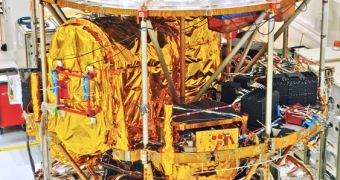According to officials at the European Space Agency (ESA), the Meteosat Second Generation-3 (MSG-3) satellite is ready for launch this summer. The spacecraft will enable the agency to continue monitoring Earth's weather patterns with extreme degrees of accuracy.
The vehicle will join two assets already in Earth's orbit. The first, called Meteosat-8 (MSG-1) was launched back in 2002, whereas the second one, called MSG-2, was launched in 2005. The first European Meteosat was orbited in 1977, ESA experts say.
The purpose of the MSG/MTG constellation is to help European forecasters improve weather prediction capabilities. Data they obtain are used for forecasts, for informing ships and aircraft about weather conditions around their areas of operations, and similar applications.
What separates MSG-3 from other spacecraft in the series is its ability to produce data of much higher resolution, on more spectral channels than ever before. This will allow climate scientists to really go to the core of weather phenomena, and see what's happening.
At this point, the constellation covers all of Europe, and portions of the North Atlantic and Africa. Together, the two satellites already in orbit supply weather data once every 15 minutes. The information is immediately centralized, and then relayed to national weather forecasters and meteorologists.
Current plans call for a total of four such satellites to be in space simultaneously. A fourth-generation spacecraft is planned, but work on it is still in its earliest stages. On the other hand, MSG-3 is scheduled to launch in June.
The satellite is being constructed by European aeronautics giant Thales Alenia Space, and will be launched into space from the Kourou Spaceport, in French Guiana, South America. It will be placed in a geostationary orbit, about 36,000 kilometers above the surface of the planet.
MTG is developed by a collaboration between Eumetsat [the European Organization for the Exploitation of Meteorological Satellites] and ESA. For a while after deployment, it will operate alongside MSG spacecraft, as well as the MetOp series of polar-orbiting spacecraft.
According to the new agreement, the future meteorological constellation will include four MTG-I imaging and two MTG-S sounding satellites. Before the constellation is deployed, two MTG-I prototypes will be launched in late 2017 and mid-2019.
“Along with keeping track of cloud development and temperature to improve weather forecasting accuracy, MSG-3 has two secondary missions in the areas of radiation and rescue,” ESA experts say.
“In addition to the advanced imaging capabilities offered by the Flexible Combined Imager, the satellites will offer an all-new infrared sounding capability and imaging of global lightning that will provide early warning of severe storms,” an ESA press release explains.
“MTG-S will also carry the Sentinel-4 payload for the Global Monitoring for Environment and Security (GMES) program. This advanced payload will analyze atmospheric chemistry and identify concentrations of trace gases like ozone and nitrogen dioxide,” the statement concludes.
ESA is keen on augmenting its presence in space, especially when it comes to Earth observation capabilities. If current plans come to fruition, the organization will have a large number of new satellites in orbit by 2020, under various programs, including Sentinel, Galileo and Swarm.

 14 DAY TRIAL //
14 DAY TRIAL //